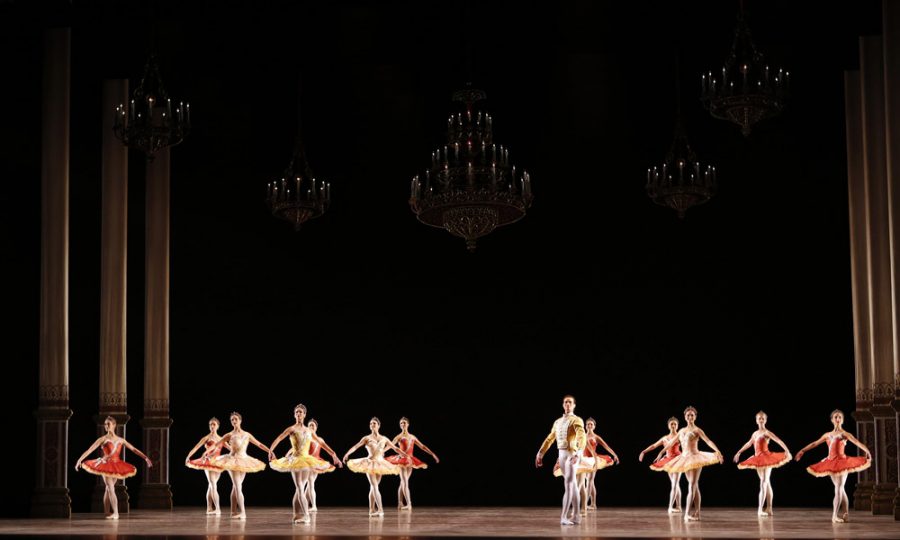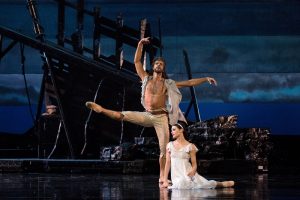

This November marks American Ballet Theatre's first season in Lincoln Center's Koch Theatre in 37 years. It is a definite step up from New York City Center's somewhat less dance-friendly space, where the company has danced its fall season for the past many years; the three works presented by the company on Saturday -- George Balanchine's "Theme and Variations", Stanton Welch's "Clear", and Alexei Ratmansky's "The Tempest" -- all made good use of the larger stage.
"Theme and Variations", which received an update in the form of new costumes this year, was in good form. Designer Zack Brown has dressed the dancers in sherbet colors -- tangerine-red, peach, and muted yellow -- which look particularly striking against the black backdrop and hanging chandeliers. The ballet, choreographed by George Balanchine for ABT in 1947, is a favorite among ballet companies, and justly so: it is exquisitely musical, grand yet modern, structurally complex without ever looking busy. The central pas de deux is a remarkable creation: it pulls the threads of tension in Tchaikovsky's music to tautness. Polina Semionova (in her debut) and Cory Stearns danced the principal roles with confidence and polish, though they could perhaps bring more nuance to their interpretation of the music -- something that will certainly come with time.
A revival of Stanton Welch's ballet "Clear" was next on the program. The ballet was created for the company in 2001, in the wake of both 9/11 and a personal tragedy in the choreographer's own life; while it is not, perhaps, a great work, it does many things very well. Set to music by Bach and danced by seven men and one woman, it offers the men of ABT a chance to show off their versatility. There is, for example, a long adagio section for two men (Thomas Forster and Daniel Mantei), something of a rarity in ballet. Forster and Mantei's styles of dancing are very different -- the former more supple and liquid, the latter cooler and lighter -- and complement each other beautifully. The choreography for the woman (Paloma Herrera) is somewhat less interesting, though her calmer demeanor contrasts nicely with the more anxious choreography for the men.

The final piece on the bill was Alexei Ratmansky's new one-act ballet, "The Tempest". Are there stories better left untold through dance? Perhaps. Narratives with winding plots or complicated backstories can certainly prove difficult to follow without the aid of words. And yet, when I heard earlier this year that Ratmansky had decided to attempt to translate Shakespeare's play into dance, I did not dismiss it out of hand. For one thing, the play's more supernatural elements -- the conjured storm, the spirits that populate the island -- are well-suited to ballet. For another, Ratmansky has demonstrated himself to be a master of storytelling: his narrative ballets, such as "The Bright Stream", "The Firebird", and "On the Dnieper", handle narrative deftly; they are by turns humorous, deeply moving, and wildly creative. Even his plotless ballets, such as "Concerto DSCH", tend to treat his dancers not just as bodies in space, but as real people.
That said, the story of "The Tempest" is just plain hard to tell without words; after all, it is a play in no small part about language itself. For his dance version of Shakespeare's play, Ratmansky uses Jean Sibelius's Op. 109 ("Incidental Music to Shakespeare's 'The Tempest'"), which -- though strange, interesting, and sometimes lovely -- does not do much to help pace the ballet effectively. As the program notes admit freely, the ballet is more fragmented than the typical story ballet as a result. Still, most of the main plot points of the play make their way into the ballet. Some work better than others: the way Ratmansky manages to explain Prospero's backstory is elegantly done, his reveries of the past segueing into the next scene smoothly. And he makes canny use of partnering to show relationships between characters: as Prospero (Marcelo Gomes) dances with his daughter, Miranda (Sarah Lane), for instance, she does very little on her own -- he manipulates her movements -- but when she dances with Ferdinand (Joseph Gorak) later in the ballet, she does so mostly on her own power. The contentious relationship between Prospero and his two slaves, Caliban (Herman Cornejo) and Ariel (Daniil Simkin), is similarly shown through their rough pas de deux. Indeed, if Ratmansky's "Tempest" picks up on any of Shakespeare's themes, it is that of manipulation -- and he uses dance to show the various shades and types of power with great success.
Less successful are the comic parts of the play, in which Caliban, Stephano, and Trinculo get drunk and mistake each other for four-limbed, two-headed monsters. In Shakespeare's play, humor and poetry, vulgarity and pathos, exist side-by-side in these scenes; yet in this ballet none of these qualities are elicited with much success. The trick played by Ariel upon the shipwrecked men (in which he scares them with visions of harpies) is, similarly, less truly frightening than it could be.
Still, the cast here is remarkable -- Gorak as the love-struck Ferdinand and Simkin as the nimble sprite Ariel, in particular -- and while the story and its themes may not always emerge clearly, there is plenty to enjoy and ponder.
American Ballet Theatre's Fall Season continues through November 10th. Check out our full event listing here: https://stagebuddy.com/listingdetail.php?lid=16082